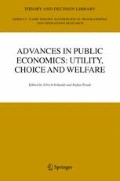Access this chapter
Tax calculation will be finalised at checkout
Purchases are for personal use only
Preview
Unable to display preview. Download preview PDF.
References
Ahlheim, M. 1993. Zur Theorie rationierter Haushalte. Ein Beitrag über die Berücksichtigung limitierter staatlicher Subventionsprogramme in der Haushaltstheorie, Heidelberg: Physica.
Ahlheim, M. 1998. “Measures of Economic Welfare”, in: S. Barbera, P.J. Hammond, and C. Seidl (eds.): Handbook of Utility Theory, Vol. 1: Principles, Dordrecht: Kluwer Academic Publisher, 483–568.
Ahlheim, M. 2003. “Zur ökonomischen Bewertung von Umweltveränderungen”, in: B. Genser (ed.): Finanzpolitik und Umwelt, Berlin: Duncker und Humblot, 9–71.
Allen, R. G. D. 1975. Index Numbers in Theory and Practice, London.
Chambers, N., C. Simmons, and M. Wackernagel. 2000. Sharing Nature’s Interest — Ecological Footprints as an Indicator of Sustainability, London: Earthscan.
Deaton, A., and J. Muellbauer. 1980: Economics and Consumer Behavior, Cambridge.
Den Butter, F. A. G. 1992. “The Mirror of Cleanliness: On the Construction and Use of an Environmental Index”, in: J.J. Krabbe and W.J.M. Heiman (eds.): National Income and Nature: Externalities, Growth and Steady State, Dordrecht: Kluwer, 49–76.
Den Butter, F. A. G., and J. A. C. van der Eyden. 1998: “A Pilot Index for Environmental Policy in the Netherlands”, Energy Policy 26(2), 95–101.
Ebert, U., and H. Welsch. 2004. “Meaningful Environmental Indices: A Social Choice Approach”, Journal of Environmental Economics and Management 47, 270–283.
Fisher, I. 1927. The Making of Index Numbers, A study of Their Varieties, Tests, and Reliability, 3rd edition (reprinted in 1967), Boston: Houghton Mifflin Company.
Hope, C., and J. Parker. 1990. “Environmental Information for All-The Need for a Monthly Index”, Energy Policy 18(4), 312–319.
Hope, C., and J. Parker. 1995. “Environmental Indices for France, Italy and the UK”, European Environment 5, 13–19.
Inhaber, H. 1974. “Environmental Quality: Outline for a National Index for Canada”, Science 186, 798–805.
Kang, S. M. 2002. “A Sensitivity Analysis of the Korean Composite Environmental Index”, Ecological Economics 43, 159–174.
Markandya, A., and N. Dale. 2001. Measuring Environmental Degradation. Developing Pressure Indicators for Europe, Cheltenham.
OECD. 2001. OECD Environmental Indicators. Towards Sustainable Development, Paris.
Ott, W. R. 1978. Environmental Indices. Theory and Practice, Ann Arbor, Michigan: Ann Arbor Science.
Pollak, R. A. 1978. “Welfare Evaluation and the Cost of Living Index in the Household Production Model”, American Economic Review 68, 285–299.
Rees, W. E. 1992. “Ecological Footprints and Appropriated Carrying Capacity: What Urban Economics Leaves Out”, Environment and Urbanization 4(2), 121–130.
Rees, W. E. 2000. “Eco-footprint Analysis: Merits and Brickbats”, Ecological Economics 32(3), 371–374.
Ten Brink, B. J. E., S. H. Hosper, and F. Colijn. 1991. “A Quantitative Method for Description and Assessment of Ecosystems: The AMOEBA-approach”, Marine Pollution Bulletin 23, 265–270.
Wiggering, H., and F. Müller. 2004: Umweltziele und Indikatoren. Wissenschaftliche Anforderungen an ihre Festlegung und Fallbeispiele, Berlin.
Wheeler, B. W. 2004. “Health-related Environmental Indices and Environmental Equity in England and Wales”, Environment and Planning A 36, 803–822.
Author information
Authors and Affiliations
Editor information
Editors and Affiliations
Rights and permissions
Copyright information
© 2005 Springer
About this chapter
Cite this chapter
Ahlheim, M., Frör, O. (2005). Constructing a Preference-Oriented Index of Environmental Quality. In: Schmidt, U., Traub, S. (eds) Advances in Public Economics: Utility, Choice and Welfare. Theory and Decision Library C:, vol 38. Springer, Boston, MA. https://doi.org/10.1007/0-387-25706-3_10
Download citation
DOI: https://doi.org/10.1007/0-387-25706-3_10
Publisher Name: Springer, Boston, MA
Print ISBN: 978-0-387-25705-1
Online ISBN: 978-0-387-25706-8
eBook Packages: Business and EconomicsEconomics and Finance (R0)

